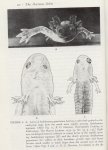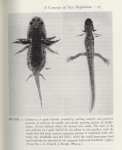Victor Chandler Twitty, Of Scientists and Salamanders (San Francisco: WH Freeman &Co., 1966) 178 pp.
Twitty sets out to trace the path of his career and the events that shaped it. So much is just chance, he notes. He started as an embryologist, and ended up studying the natural history of Taricha spp. “t can be more exciting, and often more productive, to adapt one’s course to new avenues opened up by unexpected observations in studies originally directed toward quite different goals” (p. viii).
Written to interest both the layman and the professional, he summarizes his work chronologically. It is an interesting story
I got this book because Kentwood Wells referred to it in his The Ecology and Behavior of Amphibians (review about half finished). Wells referred to the “delightful account of the excitement and frustration of fieldwork” (Wells, p. 267) in “The Pepperwood Creek Affair”, which is chapter 5 of Twitty’s book. That brief mention intrigued me enough so that when I found the book online for about $5, I had to get it. Plus, I love Tarichas.
The book is divided into five chapters, each detailing one stage of his career. After completing his undergraduate study at Butler College in Indiana, he studied embryology at Yale as a graduate student. They did, among other things, embryonic surgical experiments to determine the characteristics of embryonic cells by grafting tails, limbs, etc. to different parts of the salamander body, and even between species to see how they would grow. (See first two pictures below). They used what was then called Amblystoma punctatum (now Ambystoma maculatum), A. tigrinum, and later even did frog-salamander experiments. These experiments could not be pursued on “more advanced” animals due to their more advanced immune systems rejecting such graft attempts.
After Yale, he spent a year in Berlin (1931-2), and then moved to Stanford (CA). He believed his choice of Stanford University fortuitous because he would come to believe the newts of CA to be “unrivalled anywhere in the world” (p. 54). (At that time they were called “Triturus torosus.”)
In Stanford, their discovery of the toxicity of torosus added a new dimension to their experiments. His observations of larvae also led to the splitting of the genus into various Triturus species (four): T. torosus (the original), rivularis, similans [later granulosa], and sierrae. He said he loved the species which became known as rivularis (which he named) best. For a brief time there was even a T. twittyi (named by Sherman Bishop), but it did “not [survive] the tests of time and more rigorous systematic appraisal” (p. 68). At Stanford, Twitty also began experimenting with the pigment cells (which originate in the neural crest).
Twitty thanks the newt for the outdoor recreational opportunities that study of the animal provided. He made friends, went on vacations, and shared drinks with people whom newts brought into his life (methinks caudrama did not begin with us!).
And finally we come to the long-awaited Chapter 5, “The Pepperwood Creek Affair.” Twitty slowly moved from the lab to the outdoors (trading “wading boots and the four-wheel-drive Jeep…[for] iris shears and dissecting scope” - p.101). In his own words: “[w]here newts beckon, their follower must go, and if this exposes him and students who share his distaste for the barbecue pit and other Spartan features of a well-equipped field station—well, this is the price he must pay with all the fortitude he can muster” (p. 103).
Twitty describes creating Taricha hybrids in the labs to study, and releasing them to grow up in nature, since they were unable to keep them alive themselves in the lab long enough to raise them (though later they learned how). So on a 14,000 acre private ranch in CA full of “rivularis-ridden streams,” he decided to conduct a hybrid planting program (p. 105). They began in 1953. They fertilized rivularis-torosa hybrid eggs in the lab, and also sierrae.
OMG, could you even think of getting away with this today??? Did this not raise any ecological worries? Well, they did at least think about it, becoming concerned about their possible dispersal. Before the hybridization experiments, they conducted a series of homing experiments (which were very, but not 100%, successful). And then they released the hybrid eggs into the wild.
This aspect of the book rather horrified me, including the vast numbers of newts which were sacrificed to his experiments (he said, between 1953 and 1959, they removed over 24,000 rivularis females—and today nobody can get one). And I will not dwell on the amputations they used to identify individual animals. The homing experiments they performed by blinding newts---I am too saddened even to mention. What did they teach you in Germany, man?
And I will not dwell on the amputations they used to identify individual animals. The homing experiments they performed by blinding newts---I am too saddened even to mention. What did they teach you in Germany, man?
Sometimes I regret wasting most of my education on the useless field of literature when I could have become a scientist. But at times like this, I am glad that the only things I had to dissect in my graduate studies were poems.
I was torn about this book—the author was personable and humorous at times, and I liked him. I liked him for liking Tarichas and devoting himself to them. But I did not like some aspects of the methods and nature of his experiments.
Twitty admits that “we are messing up Nature rather badly in Pepperwood Creek” (p. 151) but he offers no apology or plan to clean it up when the experiments are over (they were not over by the time he wrote this memoir).
Rather, he admits that while at first he assumed his hybrids could not establish themselves well enough to have a “major impact on natural parental populations”, he was wrong about that. And further: "[w]hatever the eventual outcome of the hybrid planting program,” he does not seem concerned, but in fact, he sees it as an “opportunity for a new period of evolutionary flowering” (p. 158).
The hair on my furry otter tail stands on end.
.
.
Available used as an import on Amazon starting at $4.60.
Twitty sets out to trace the path of his career and the events that shaped it. So much is just chance, he notes. He started as an embryologist, and ended up studying the natural history of Taricha spp. “t can be more exciting, and often more productive, to adapt one’s course to new avenues opened up by unexpected observations in studies originally directed toward quite different goals” (p. viii).
Written to interest both the layman and the professional, he summarizes his work chronologically. It is an interesting story
I got this book because Kentwood Wells referred to it in his The Ecology and Behavior of Amphibians (review about half finished). Wells referred to the “delightful account of the excitement and frustration of fieldwork” (Wells, p. 267) in “The Pepperwood Creek Affair”, which is chapter 5 of Twitty’s book. That brief mention intrigued me enough so that when I found the book online for about $5, I had to get it. Plus, I love Tarichas.
The book is divided into five chapters, each detailing one stage of his career. After completing his undergraduate study at Butler College in Indiana, he studied embryology at Yale as a graduate student. They did, among other things, embryonic surgical experiments to determine the characteristics of embryonic cells by grafting tails, limbs, etc. to different parts of the salamander body, and even between species to see how they would grow. (See first two pictures below). They used what was then called Amblystoma punctatum (now Ambystoma maculatum), A. tigrinum, and later even did frog-salamander experiments. These experiments could not be pursued on “more advanced” animals due to their more advanced immune systems rejecting such graft attempts.
After Yale, he spent a year in Berlin (1931-2), and then moved to Stanford (CA). He believed his choice of Stanford University fortuitous because he would come to believe the newts of CA to be “unrivalled anywhere in the world” (p. 54). (At that time they were called “Triturus torosus.”)
In Stanford, their discovery of the toxicity of torosus added a new dimension to their experiments. His observations of larvae also led to the splitting of the genus into various Triturus species (four): T. torosus (the original), rivularis, similans [later granulosa], and sierrae. He said he loved the species which became known as rivularis (which he named) best. For a brief time there was even a T. twittyi (named by Sherman Bishop), but it did “not [survive] the tests of time and more rigorous systematic appraisal” (p. 68). At Stanford, Twitty also began experimenting with the pigment cells (which originate in the neural crest).
Twitty thanks the newt for the outdoor recreational opportunities that study of the animal provided. He made friends, went on vacations, and shared drinks with people whom newts brought into his life (methinks caudrama did not begin with us!).
And finally we come to the long-awaited Chapter 5, “The Pepperwood Creek Affair.” Twitty slowly moved from the lab to the outdoors (trading “wading boots and the four-wheel-drive Jeep…[for] iris shears and dissecting scope” - p.101). In his own words: “[w]here newts beckon, their follower must go, and if this exposes him and students who share his distaste for the barbecue pit and other Spartan features of a well-equipped field station—well, this is the price he must pay with all the fortitude he can muster” (p. 103).
Twitty describes creating Taricha hybrids in the labs to study, and releasing them to grow up in nature, since they were unable to keep them alive themselves in the lab long enough to raise them (though later they learned how). So on a 14,000 acre private ranch in CA full of “rivularis-ridden streams,” he decided to conduct a hybrid planting program (p. 105). They began in 1953. They fertilized rivularis-torosa hybrid eggs in the lab, and also sierrae.
OMG, could you even think of getting away with this today??? Did this not raise any ecological worries? Well, they did at least think about it, becoming concerned about their possible dispersal. Before the hybridization experiments, they conducted a series of homing experiments (which were very, but not 100%, successful). And then they released the hybrid eggs into the wild.
This aspect of the book rather horrified me, including the vast numbers of newts which were sacrificed to his experiments (he said, between 1953 and 1959, they removed over 24,000 rivularis females—and today nobody can get one).
Sometimes I regret wasting most of my education on the useless field of literature when I could have become a scientist. But at times like this, I am glad that the only things I had to dissect in my graduate studies were poems.
I was torn about this book—the author was personable and humorous at times, and I liked him. I liked him for liking Tarichas and devoting himself to them. But I did not like some aspects of the methods and nature of his experiments.
Twitty admits that “we are messing up Nature rather badly in Pepperwood Creek” (p. 151) but he offers no apology or plan to clean it up when the experiments are over (they were not over by the time he wrote this memoir).
Rather, he admits that while at first he assumed his hybrids could not establish themselves well enough to have a “major impact on natural parental populations”, he was wrong about that. And further: "[w]hatever the eventual outcome of the hybrid planting program,” he does not seem concerned, but in fact, he sees it as an “opportunity for a new period of evolutionary flowering” (p. 158).
The hair on my furry otter tail stands on end.
.
.
Available used as an import on Amazon starting at $4.60.
Attachments
Last edited:



